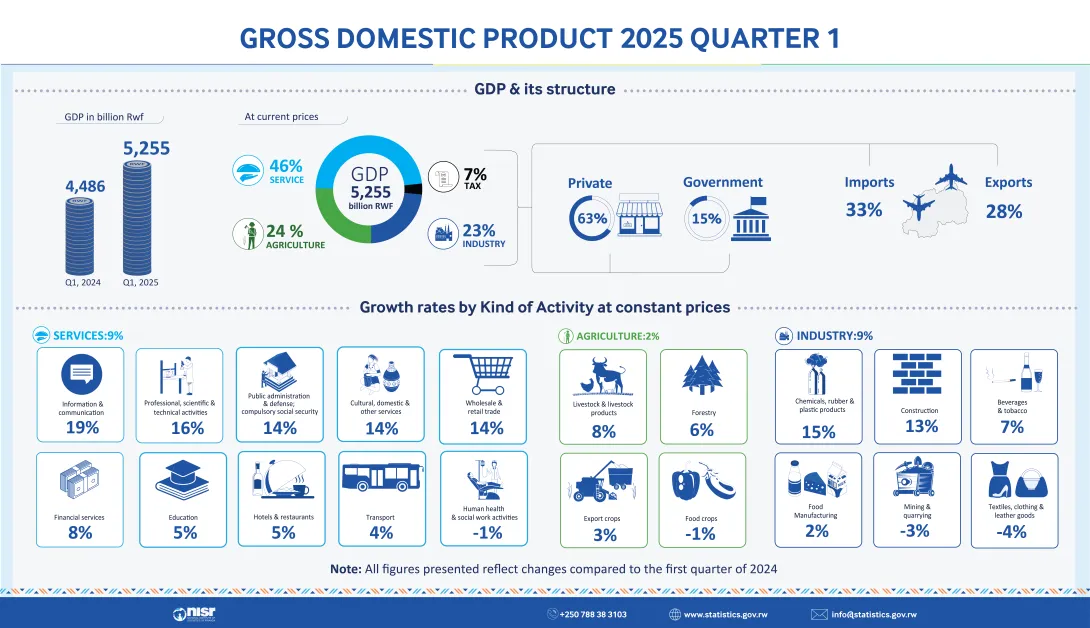Rwanda's Economy Expands by 7.8% in Gross Domestic Product (GDP) First Quarter of 2025 with Strong Performance in Industry and Services Sectors Bolsters Economic Growth

The National Institute of Statistics of Rwanda (NISR) has officially released the Gross Domestic Product (GDP) of the first quarter (Q1) of 2025, revealing a continued upward trend in the country’s economic performance. Despite moderate inflationary pressures, particularly from rising prices of core goods and fresh food items, Rwanda’s economy demonstrated resilience and robust growth, underscoring the effectiveness of ongoing economic reforms and sectoral development strategies.
According to the Q1 2025 report, Rwanda’s GDP at current market prices was estimated at Frw 5,255 billion, this represents a notable increase from Frw 4,486 billion recorded during the same period of Q1 2024. After adjusting for inflation, this translates to a real GDP growth rate of 7.8%, indicating that the country’s economy is not only expanding in size but also maintaining strong and stable performance. This growth demonstrates Rwanda’s continued recovery from the global economic slowdown triggered by the COVID-19 pandemic and global supply chain disruption caused by the middle east conflicts and reflects ongoing efforts to strengthen key economic sectors and ensure macroeconomic stability.
Sectoral Performance Overview
The report attributes this growth to a combination of strong performances in the industry and services sectors, along with a moderate but stable contribution from agriculture. The sectoral distribution of GDP in Q1 2025 was as follows:
- Services sector: Contributed 46% of total GDP and grew by 9%, maintaining its role as the dominant driver of economic activity. This reflects ongoing expansion in key service areas including trade, transport, communication, finance, education, and healthcare.
- Agriculture sector: Accounted for 24% of GDP and grew by 2%. Although modest in its growth, the sector remained essential in supporting rural livelihoods and food security, especially in the face of fluctuating weather conditions and commodity price trends.
- Industry sector: Contributed 23% to GDP and grew by 9%, supported by increased output in construction, manufacturing, and processing activities. This highlights Rwanda’s progress in diversifying its economic base and advancing its industrialization agenda.
- Net taxes on products: Represented the remaining 7% of GDP, reflecting the government’s fiscal policies and domestic resource mobilization efforts.
Economic Resilience Amid Inflationary Pressures
While the report acknowledges slight inflationary pressures during the quarter driven primarily by increases in the prices of fresh food and core goods, these did not significantly deter economic momentum. Rwanda’s continued investment in infrastructure, productivity enhancement, and human capital development has played a vital role in supporting growth despite external and internal economic challenges.
Strategic Implications
The first quarter GDP performance sets a positive tone for the rest of the year, reinforcing Rwanda’s long-term vision for economic transformation and inclusive growth. The data also provides a vital benchmark for policymakers, investors, and development partners in assessing the effectiveness of current programs and identifying areas for further support and innovation.
NISR’s Role
As the nation’s official statistics body, the National Institute of Statistics of Rwanda (NISR) remains committed to delivering timely, reliable, and comprehensive economic data. The release of this quarterly GDP report is part of NISR’s mandate to inform evidence-based decision-making and promote transparency in economic reporting.
For more detailed data, find the full GDP Q1 2025 report at NISR website https://statistics.gov.rw/statistical-publications/gross-domestic-product/gdp-national-accounts-first-quarter-2025
MATESO Andre
Public Relations and Communication Officer
